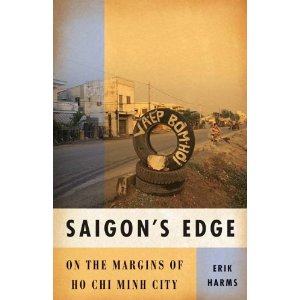Professor Harms
Erik L. Harms
 Assistant Professor of Anthropology (PhD, Cornell University, 2006)
Assistant Professor of Anthropology (PhD, Cornell University, 2006)
I am a social-cultural anthropologist specializing in Southeast Asia and Vietnam. My ethnographic research in Vietnam has focused on the social and cultural effects of rapid urbanization on the fringes of Saigon—Ho Chi Minh City. This research appears in my book, Saigon’s Edge: Space, Time, and Power on Ho Chi Minh City’s Rural Urban Margin (University of Minnesota Press), which explores how the production of symbolic and material space intersects with Vietnamese concepts of social space, rural-urban relations, and notions of “inside” and “outside.”
More recently, my work has focused on the uses and abuses of “culture” and “urban civility” in urban Vietnam, and how this civilizing discourse entwines with spatial action in ways that legitimize broad-scale privatization. This new research explores how the study of social space can reveal unspoken relationships of power and ideology in post reform-era Vietnamese cities. While grounded ethnographically in Vietnam, my research and teaching seeks at all turns to connect my own work with larger world-historic processes, unraveling the interaction between culture and politics, and the ways in which everyday acts are informed by larger political agendas. In my teaching I offer a rotating mix of courses on Southeast Asian area studies, postwar Vietnam, urban anthropology, as well as theories of space, time, and social action.
Book: Saigon’s Edge
 Saigon’s Edge describes the ‘social edginess’ experienced by people who live on the rural-urban fringe of Hồ Chí Minh City. Building from eighteen months of ethnographic fieldwork in the outer-city district of Hóc Môn, this work shows what happens when rural and urban Vietnam intersect. In contrast to an idealized Vietnamese model of urban space that divides the city into inside and outside, as well as rural and urban, the people who live in outer city districts like Hóc Môn are ambiguously in between worlds. Neither inside nor outside, they are always uncomfortably both.
Saigon’s Edge describes the ‘social edginess’ experienced by people who live on the rural-urban fringe of Hồ Chí Minh City. Building from eighteen months of ethnographic fieldwork in the outer-city district of Hóc Môn, this work shows what happens when rural and urban Vietnam intersect. In contrast to an idealized Vietnamese model of urban space that divides the city into inside and outside, as well as rural and urban, the people who live in outer city districts like Hóc Môn are ambiguously in between worlds. Neither inside nor outside, they are always uncomfortably both.
Prioritizing lived experience and the everyday dynamic of social life on the fringes of this rapidly expanding city, this ethnography exposes how life on the city’s edge can be both alienating and empowering. The same properties that cast the outer-city as a zone excluded from the networks of power and privilege associated with the inner-city can also offer a means of thwarting the status quo. Saigon’s edge is truly a double edge–an edge that cuts people off from access to resources and a cutting-edge zone of opportunity. By linking the multiple meanings of life on the edge to idealized Vietnamese stereotypes of rural and urban difference, and by showing parallels within Vietnamese kinship idioms of “inside” and “outside,” Saigon’s Edge provides a novel way of understanding social constructions of time and space in contemporary Vietnam. In addition to providing a local case study of urban change that builds from ethnographic descriptions of the rapid urban development in Hóc Môn, the work also provides a window into Vietnam’s larger turn towards ‘market socialism’ and the celebration of urbanization. It shows how these transformations, which are clearly connected with globalization trends, still require us to pay close attention to particular Vietnamese models of social and spatial organization.